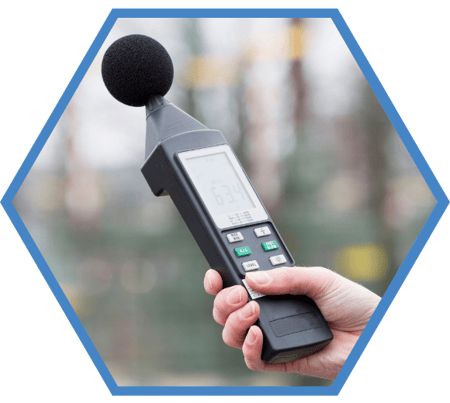NOISE MEASUREMENTS
Sonometry
Key tool for measuring industrial noise

By Tommy Keegan | Industrial Audiologist
Sonometry is a branch of science dedicated to the in-depth study of the properties of sound, encompassing crucial aspects such as intensity, frequency and duration. This discipline uses specialized instruments, notably sound level meters, to measure and analyze sound levels in a variety of environments, both natural and man-made. These tools enable sonometry to quantify ambient noise precisely, making it easier to understand its impact on human health and the environment.
The applications of sonometry are vast and diverse. In urban areas, it is essential for studying and managing noise pollution, helping to improve the quality of life of residents by reducing excessive noise. In the arts, sonometry plays a key role in optimizing acoustic quality, whether for music, film or theater, ensuring an enriching and immersive sound experience. It is also used to design acoustically optimized spaces, ensuring that every note or dialogue is heard with clarity and precision.
In industry: A regulatory and sanitary necessity
In industrial environments, sound level measurement is essential for assessing and controlling noise levels. This intensity, expressed in decibels (dB), must comply with thresholds rigorously established by regulations. Prolonged exposure to high noise levels can have irreversible consequences on hearing health, such as tinnitus, progressive hearing loss or occupational deafness.
The harmful effects of noise are not limited to hearing. In fact, chronic noise can have profound and varied repercussions on people's overall health. It is well documented that continuous exposure to high noise levels can lead to impaired concentration, making it difficult to perform tasks requiring sustained attention. Moreover, constant noise is a major stress factor, which can exacerbate anxiety and lead to long-term mental health problems. Sleep disruption is also common, as noise can prevent restful rest, leading to fatigue and irritability. Even more alarmingly, studies have shown a link between noise exposure and the development of cardiovascular diseases, such as high blood pressure and heart attacks. Sonometry is thus becoming a crucial tool not only for ensuring that working environments comply with regulatory noise standards, but also for playing a vital preventive role in protecting workers' physical and mental well-being. By monitoring and controlling noise levels, companies can create a healthier and safer working environment, contributing to the overall health and productivity of their employees.
The starting point for prevention and technical improvements
An important advantage of sonometry is its ability to provide precise, detailed data on the noise sources present in a given environment. This information is essential for deploying targeted and effective prevention policies. For example, by accurately identifying risk areas within a plant, it becomes possible to implement tailor-made solutions such as :
-
The installation of soundproofing systems for noisy machinery, which can include acoustic enclosures or absorbent panels specially designed to reduce noise levels at source.
-
The use of acoustic barriers or noise curtains, which serve to isolate noisy areas from quieter work spaces, thus minimizing noise propagation and protecting employees from the harmful effects of prolonged exposure.
-
Designing workstations to reduce noise exposure, which may involve reorganizing space to move workers away from noise sources, installing acoustic partitions, or adopting work practices that limit the time spent in noisy areas.
-
The application of appropriate hearing protectors, determined according to the ambient noise levels measured by sonometric surveys.
Regular monitoring for lasting compliance
Sound level measurement is an essential tool for ensuring regular, accurate monitoring of noise levels in environments where noise can reach dangerous levels. By carrying out periodic and systematic measurements at different workstations, companies can:
-
Ensure ongoing compliance with occupational health and safety regulations, which aim to protect employees from the harmful effects of excessive noise.
-
Quickly and effectively detect areas where noise thresholds are exceeded, enabling immediate intervention to reduce noise to safe levels.
-
Continuously optimize working conditions by identifying opportunities for improvement in noise management.
These strategies, when implemented consistently and continuously, help to limit noise nuisance at its source, offering improved protection for employees.
Employee awareness and training
In addition to technical measurements, the data obtained from sonometry can be used to educate workers about their essential role in preventing occupational deafness.
By analyzing the data, occupational health and safety managers can identify high-risk areas, understand variations in noise levels over time and the specific conditions that contribute to these risks, and design targeted, customized training sessions where employees learn how to use personal protective equipment (PPE) correctly.
What's more, sharing this information with workers fosters a proactive safety culture where everyone feels involved in protecting their own hearing health. This approach complements technical initiatives by reinforcing individual and collective responsibility.
Frequently asked questions
Sonometry
Answer

Measure the risk with our noise measurement services for industry
Start your hearing loss prevention program with reliable noise measurements to develop an effective action plan to prevent occupational hearing loss.

-1.png?width=144&height=72&name=BJA%20_%20Logo%20Color%20%20(1)-1.png)